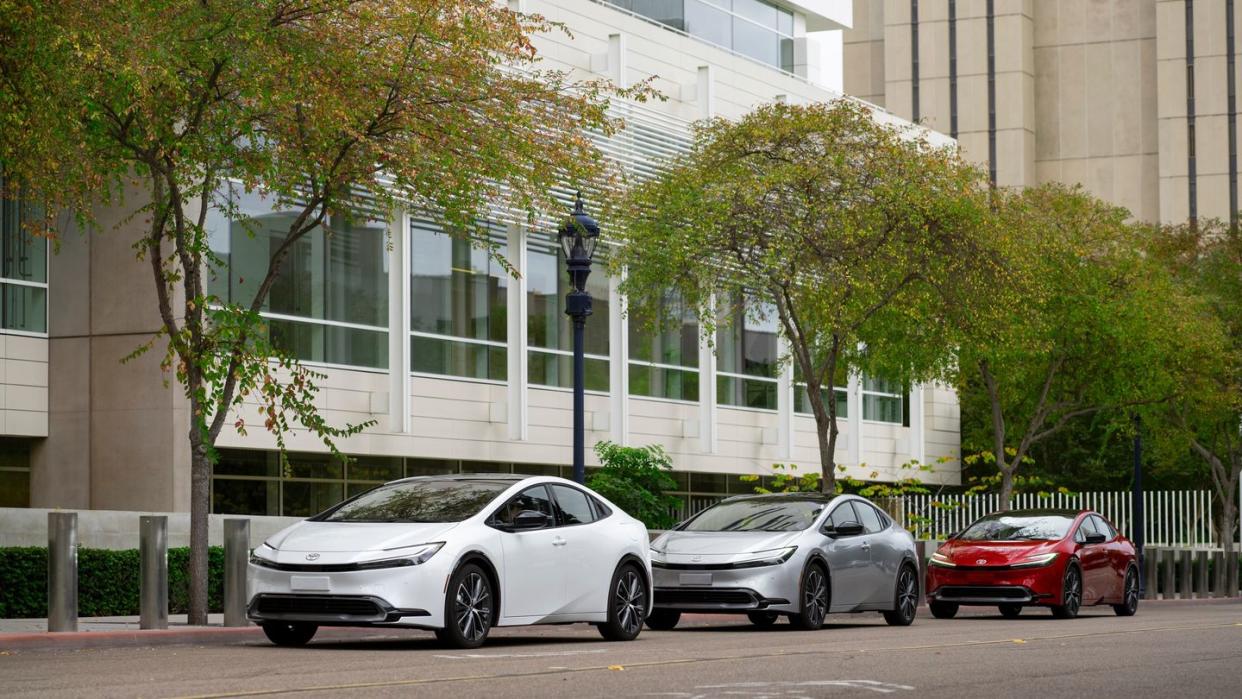What's the Difference between a Parallel and a Series Hybrid, and Does It Matter to Buyers?

Drivers of hybrid cars today don't necessarily understand how they work under the hood. The good news is, they don't have to; if the vehicles are properly designed, there's no reason to give it much thought. But with electric vehicles now neck and neck in sales with hybrids, the two categories are increasingly intertwined.
This is most evident in the upcoming Ram 1500 Ramcharger. It's not a hybrid like a Prius, in which the engine and electric motors combine mechanically to power the vehicle. Instead, the big, heavy, tow-capable full-size pickup is a battery-electric truck with 145 miles of battery range and a V-6 "generator"—Ram insists no one refer to it as an engine—under the hood.
The Ramcharger's 3.6-liter engine powers a 174-hp generator that's used solely to recharge the battery. After the battery runs out of energy, the 27-gallon gas tank provides enough energy to power the Ram for 545 more miles. The idea is that it's an EV truck around town, presuming owners plug it in, but it also carries a generator for long trips, towing, and other energy-intensive duties.
Whether shoppers will understand this is debatable. Salespeople will undoubtedly struggle with the "Plug in daily, use gasoline for longer trips" message—and some owners may end up plugging in very little, if at all. But the Ramcharger is a good opportunity to review the differences between what are called series and parallel hybrids (not that new-car shoppers are likely to use those terms).
Series Hybrids
The earliest hybrids, dating from 1900 through 1920, were all series hybrids like the Ramcharger. The concept is simple: The vehicle runs on electricity from the battery, and when the battery is depleted or more power is needed, the gasoline engine switches on to power a generator. That produces current that goes to the battery pack, and then the wheels. The battery acts as a buffer, so the generator can operate at its most productive speeds—meaning it may not run from 600 to 6000 rpm, as an engine that powers the wheels has to.
The important part to understand is that engine torque only goes to run the generator, not turn the wheels. The engine output shaft isn't mechanically connected to the wheels; they are powered solely by one or more electric motors.
Diesel-electric railroad locomotives have used this layout for many decades, in part because it's well adapted to steady vehicle speeds, which don't have much variance in power demand. The power required by passenger road vehicles, on the other hand, may vary by an order of magnitude or more. At the low end is steady-speed cruising on flat roads; at the high end is accelerating up a steep hill to merge into traffic.
Remarkably, the forthcoming Ramcharger will be only the third series-hybrid vehicle sold in North America in modern times. Of the other two, the only one sold in volume was the 2014–2021 BMW i3 REx—a version of the battery-electric i3 model that added a range-extending two-cylinder engine to act as a generator. The other was the 2012 Fisker Karma and its related successors the Karma Revero and GS-6, all sleek four-door luxury sedans. None remain in production.
Parallel Hybrids
Of 25 million gasoline-electric hybrids on the world's roads, most are Toyotas—and most of those use the company's classic two-motor power-split parallel hybrid system. It used to be called Hybrid Synergy Drive, a phrase that's probably about as mystifying to the average shopper as "parallel hybrid."
Reduced to its basics, a parallel hybrid system uses both the engine and one or more electric motors to power the wheels—either together or separately. Toyota's system, launched in 1997 on a Japan-only Prius that arrived in the U.S. in 2000, has two motors connected to the engine via a planetary gearset that also functions as a continuously variable transmission. They draw current from, and recharge, a small battery pack of roughly one kilowatt-hour.
If the car is operating at lower speeds, under lighter loads, one or two electric motors can power the vehicle alone, and the engine stays off. Heavy acceleration or higher speeds will cause the engine to switch on, and that's where it gets complicated. Sometimes it will power the car almost entirely by itself; in other cases, the vehicle software (which is complex, to say the least) will draw power from a combination of the engine output shaft and the motors.
The key to a hybrid's efficiency is that it recaptures energy from momentum that would otherwise be wasted as brake heat. Electric motors can instantly switch from delivering power to generating it, and regenerative braking—using a motor as a generator when the car slows—recharge the battery to store that energy. Up to 30 percent of the energy used to power the car can be recaptured in certain cases, especially stop-and-go traffic where the car can run frequently on electric power.
As mentioned earlier, the Toyota system also functions as a transmission, while other parallel hybrid systems use a single motor between the engine and a conventional transmission. They're simpler, and easier to adapt from gasoline-only models, but not as flexible.
A two-motor system can use one motor to turn the wheels while the other recharges the battery via engine power, regenerative braking, or both. A one-motor system can power the car or recharge the battery, but not both at the same time.
The software to make all this work is extremely complex. Control algorithms must continuously vary the power drawn from the battery and from the engine to maximize use of battery power and minimize fuel burned. Every maker that has launched a hybrid has discovered that getting that last 10 percent of smoothness in blending engine, motor(s), and braking (both friction and regenerative) is extraordinarily hard—and each generation of hybrid gets smoother as those lessons are painfully learned.
You Might Also Like

